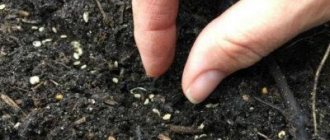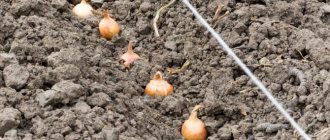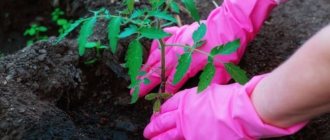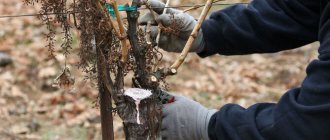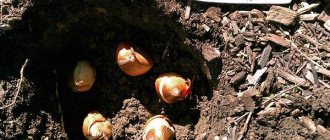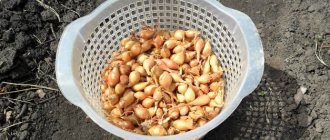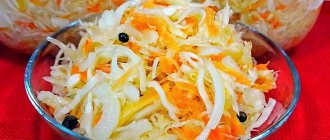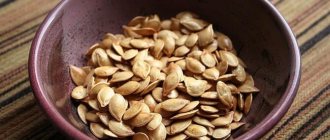For planting in the fall, for example, in October, not all varieties of onions are suitable for winter. But even the right choice of variety does not guarantee high yields. In order for the result to please you, you will have to combine competent agricultural technology with the quality of the material, adhere to planting deadlines, listen to the advice of experienced gardeners, study the lunar calendar and avoid common mistakes that beginners make.
In this article we will talk about all the intricacies of planting winter onions in October.
What varieties are suitable for October planting of onions?
In the fall before winter, you cannot plant spring varieties, only winter ones, since they are fully adapted to cold winter conditions, they hibernate all winter and only wake up in the spring.
| Varieties / Region | Moscow region | Ural | Siberia | Leningrad region |
| Arzamas | + | + | ||
| Bessonovsky | + | + | ||
| Annual Siberian | + | |||
| Radar | + | + | ||
| Red Baron | + | |||
| Red Semko | + | + | ||
| Swift | + | |||
| Senshui | + | |||
| Strigunovsky | + | + | ||
| Sturon | + | |||
| Centurion | + | + | ||
| Shakespeare | + | + | ||
| Struttgarter Riesen | + | + | ||
| Ellan | + | + |
Sowing onion
Onions are planted in the fall before winter in frozen soil. The furrows are made with a distance of 20 cm. The seeds are sown thickly, after which they are sprinkled with peat or humus. In May or early June (depending on the weather) it will be possible to collect healthy greens.
Knowing how to properly plant seedlings before winter and when to plant them in your region, you will easily cope with the task and next season you will receive the harvest two to three weeks earlier. You can also plant carrots, garlic, beets and various greens in the fall.
How to plant onions in October, planting patterns
To obtain lush feathers and large onions, it is necessary to prepare the site, winter planting material and take into account the placement scheme before winter.
Site preparation
Before winter, some winter varieties of red and yellow onions are planted. All of them are considered salad vegetables and are not suitable for long-term winter storage. It is better to plant winter onions after:
- melons;
- cucumbers;
- watermelons;
- green manure;
- tomatoes;
- zucchini;
- squash.
ATTENTION! Before winter, you cannot plant in an area where root vegetables, garlic, and onions previously grew.
The best location for a winter onion plantation will be a high area, well lit by the sun. It is advisable that the snow disappears from it first. If planted in the shade and in lowlands, the onions may become wet over the winter. In addition, in the shade the harvest will be small.
It is recommended to prepare the future winter bed in the fall 14 days before the procedure - dig it deep. If the soil is dense, add sand; sandy soil, add clay, otherwise it will not retain moisture. In case of acidic soil, you will have to lime the area before winter, and in poor soil it is recommended to add rotted manure (10 l), superphosphate (20 g) and potassium fertilizer (according to instructions), per 1 m2.
How to prepare the bulbs
ATTENTION! To prevent onions from sprouting in the spring, it is recommended to plant small onions in the fall - wild oats, the diameter of which does not exceed 1 cm. If you plant large material, it will definitely shoot.
14 days before being buried in the ground in the fall, it is recommended to pickle the wild oatmeal by soaking it in hot water for 3 hours, and then putting it in a solution of the drug Maxim for 30 minutes. Pickle in potassium permanganate for an hour.
Planting scheme
On the prepared area, beds should be formed - up to 20 cm in height, 1-1.5 m wide.
Step-by-step landing instructions:
- Before planting in the fall, the area should be watered with a weak solution of potassium permanganate.
- In the beds you need to make grooves 65-80 cm deep. The distance between the rows is 20 cm.
- Deepening winter seedlings into the furrows, maintaining a distance of 4-5 cm between them.
- The top of the groove should be covered with soil and slammed down with the palm of your hand.
- Watering is moderate.
- With the first winter frosts, it is necessary to mulch the bed. Dry grass, spruce branches, chopped straw, and sawdust can be used as mulch.
Planting depending on region
Landing in the Moscow region
Planting onions in the Moscow region is almost no different from cultivating them in Ukraine or other warm regions. The only problem can be a too cold winter, but if the temperature does not drop below -15 ºC, and you cover the onions for the winter, then they will not be in danger of freezing. If the frosts are stronger, but there is a lot of snow, then we can only hope that in this case everything will go well.
Planting onions in autumn in the Urals
Planting and caring for winter onions in the Urals is somewhat different from growing this crop in areas with a temperate climate. For example, planting dates shift closer to the beginning of autumn - from late September to mid-October. Shelter for the winter in the Urals is mandatory, in addition, not every variety can be planted before winter in the Ural climate, but only those that have high winter hardiness.
How to plant in Siberia
Unfortunately, severe Siberian frosts do not allow us to speak with confidence about the possibility of cultivating winter onions in this region. If you guess the timing of planting, the variety and the winter weather, it is quite possible that your efforts will be crowned with success. But if you are unlucky, you can always sow onions in the spring.
What is winter planting of onions and how to do it?
When cultivating onions for turnips, you need to plant the sets in the fall at a distance of 10 cm. In the row spacing - 20 cm. If the purpose of deepening is greens, then the bulbs can be placed more densely - leave 8 cm between the rows, maintain a planting step of 3 cm.
The procedure is carried out on damp soil. In grooves 5 cm deep, sand is poured at the bottom of each of them. The oatmeal is laid out in grooves and sprinkled with sand. After 14 days, the soil is mulched with dry leaves or hay.
Care
During germination, it consists of weeding it from weeds and timely watering, as well as loosening it to a depth of no more than 3 centimeters. The crust of soil that has formed after rain or watering must be carefully broken without damaging the onion, otherwise it can cause harm and slow down its growth.
The harvest should begin at the end of summer or at the beginning of autumn, when the green feathers gain growth and full strength. If you really want to, you can pluck the feathers earlier, then they will be very young, small shoots.
Pests on onions and ways to combat them
Seeds prepared for planting may be infected with pest larvae. Preventive treatment in this case is a mandatory measure. Pre-soaking onions in manganese (pour 1 g per 1 liter of water for 20-25 minutes) or in hot water (50°C, soak for 10-15 minutes) will help improve the health of onions. To remove nematode larvae, you can treat the onions with salt (soak 3 cups of salt in a bucket of water for 24 hours).
Most often, onions suffer from peronosporosis and downy mildew (onion feathers help to notice the disease). The most common measure to defeat a plant disease is to treat it with a copper-containing preparation. You can spray with copper sulfate; it is a broad-spectrum fungicide, and the gardener knows how blue solution helps in the fight against pathogens both in the garden and in the beds. The best solution for preventing onion diseases is treating it with CuSO4 before planting. It is also effective to pour copper sulfate over the area reserved for onions (1 tbsp of powder per 10 liters).
All this fuss with the seedlings should begin 20-25 days before planting. The first step is to organize the heat, that is, you can simply bring the onions into a room where the temperature is above 17°C. A day before landing, you need to warm it up on the battery. All these measures will reduce bolting and speed up the germination of seedlings. In case of force majeure, you can soak in hot water (50°C, 10 minutes), then place the onions in cold water, dry and keep in a damp burlap until planting.
Common mistakes
- Excessive watering of the bed in the fall will lead to infection with fungus, as a result of which the planting material will simply rot.
- Insufficient watering will cause the beds to dry out.
- Fertilizers should be applied in the fall when preparing the soil, and not during planting, otherwise the onions will turn into feathers.
- If you do not loosen the bed, oxygen will not reach the roots and the vegetable will stop developing.
- To get a good harvest, it is recommended to choose the right varieties that can be zoned in the region.
- If planting is not done in a timely manner, wild oats may begin to feather feathers with the onset of winter cold, and this is unacceptable.
- Some people inadvertently plant winter seedlings upside down.
The main advantages of autumn planting
In the spring, every minute counts in the garden. Winter crops help out. They are less demanding to care for - just weeding, watering, and, as necessary, treatment for diseases and pests.
If planting onions according to the lunar calendar (taking into account weather conditions, of course) was successful:
- Only strong plants can withstand winter, which means that in spring and summer the risk of rot infection is reduced and high-quality planting material can be collected for the next season;
- already in early May you can collect the first feathers;
- you won’t have to waste time breaking the arrows;
- When harvesting early, the beds will be freed up and something early ripening, for example, greens, can be planted on them.
Answers to frequently asked questions
What is better for planting in the autumn - nigella or sevok?
Nigella is needed to obtain sets, and sets are needed for bulbs.
Is it possible to plant winter crops without pre-soaking?
It is recommended not to soak onions before planting them for the winter. If necessary, you can etch for half an hour in a weak solution of potassium permanganate, but then dry.
Do I need to use fertilizers when planting?
It is necessary to fertilize the soil when preparing the bed; you cannot apply fertilizer directly when deepening it, otherwise feathers will grow.
What is the depth of planting of seedlings?
Each onion is buried 5-8 cm. But you need to look at the size of the material.
Planting onions before winter - saving time in spring
In the spring, the summer resident has a lot of worries, so to save time, you can sow everything possible before winter: carrots, beets, radishes, garlic, onions, spinach. Planted on time, the listed crops germinate earlier in the spring, are the first to begin to bear fruit, and the harvest is often of much higher quality than with traditional spring sowing. The main thing is to try not to rush, but also not to miss the favorable time for planting.
As for onions, most authors of gardening literature advise sticking to late planting dates. If the autumn has been warm and long, and the onions have already been planted, they can sprout and in this state go into the winter. Most likely it will overwinter successfully and will not freeze, but the yield will be worse.
When is the best time to plant?
Traditionally, onions are planted before winter from the end of September, and end on October 14-20. But still, the most optimal, favorable time is the beginning of October. But, again, you need to rely on the weather forecast. The planting time depends greatly on the climatic conditions of a particular autumn.
In exceptional cases, onions can be planted in early November, but the soil must first be warmed by throwing a film over the bed. After waiting for some warming, they begin planting.
What does autumn planting give?
Autumn planting allows you to get a harvest of onions already in May, and turnip onions grow by the end of July and have time to fully ripen. A huge plus is that cleaning takes place in the summer. In the July heat, onions can be dried easily and quickly, and they will be stored well.
In practice, however, it has been noticed that when planting in spring, the onions turn out to be larger and there is no risk that the sets will be overtaken by frost (as with winter sowing).
So, planting onions before winter has its pros and cons. When determining when to plant bulbs, you need to focus on the weather. And the Lunar calendar will also help with this.
Features of the region
The climate in the Moscow region is not as warm as in the southern part of the country. But not as severe as in Siberia and the Urals. Autumn is quite warm, but frosts often occur. Suitable planting days for onions begin when the average daily air temperature no longer rises above – 5 °C. Heads planted in the ground must have time to form roots before frost. This usually takes about a month. Onions planted before winter can be harvested next summer, a couple of months earlier. This will allow you to use the bed later to grow something else.
Methods of growing onions
There are two main ways to grow onions.
Regular (“set”)
- Seeds (nigella) are taken from the mother turnip bulb and sown in the soil.
- From them they produce onion sets or waterweed.
- In the 2nd year, onion sets are planted, from which a full-fledged turnip bulb grows.
The main disadvantage of this method is the very long time it takes to obtain a full-fledged turnip and the higher cost of production.
Seed (“nigella”)
Growing mother turnip bulb (nigella) from seeds as an annual crop. Including through seedlings.
In the south of the Russian Federation, nigella can be sown before winter or in early spring directly into open ground. Because due to the long warm season, the bulbs of early varieties and hybrids ripen in one year.
But in more northern regions (middle zone, Moscow region, North-West, Volga region, Ural, Siberia, Far East), you can get a harvest in the year of sowing only by growing seedlings.
Especially medium and late varieties of onions, which have a long growing season (4-5 months): leeks or “Exhibition” varieties.
Advantages of the nigella seedling method
- It is cheaper to grow full-fledged turnips from chives than from onion sets.
- You can get a harvest in one season, and not in 2-3 years.
- Reducing the vegetative period of onions in open ground by 50-60 days, which makes it possible to grow onions weighing 100-400 grams in one season. Including in regions with short summers and autumns.
- Increasing the shelf life of onions. An annual turnip does not shoot shoots during the growing season and therefore ripens better. And due to better ripening, after harvesting, the bulbs can be stored for up to nine months without rotting or sprouting.
Preparing the bulbs
Planting material must be sorted. Throw away rotten and diseased bulbs immediately. If slight damage is noticeable on the peel, you can use such specimens for food. Small fruits are separated from large ones. To prevent the development of diseases, all onions should be treated with a saturated solution of potassium permanganate. Soak them in the liquid for at least 10 minutes. Then dry them thoroughly. If this is not done, the planting material will be damaged.
To make the seedlings form arrows faster, you can pour boiling water over it and dry it near the battery before planting. Under normal conditions, the first shoots appear in the second half of March. To stimulate the formation of the root system, onions can be soaked in a biostimulator, this will speed up germination.
Important!
Fertilizing the holes with ash acts as a prevention of gray rot in onions and serves as a source of potassium.
